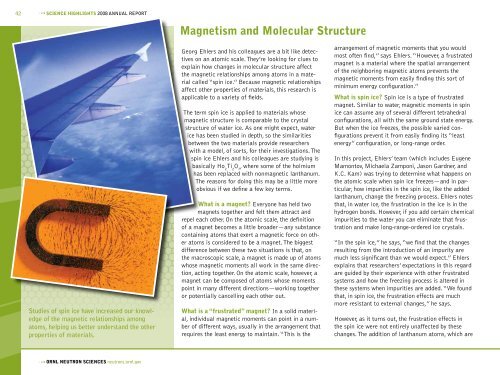Neutron Sciences 2008 Annual Report - 17.79 MB - Spallation ...
Neutron Sciences 2008 Annual Report - 17.79 MB - Spallation ...
Neutron Sciences 2008 Annual Report - 17.79 MB - Spallation ...
You also want an ePaper? Increase the reach of your titles
YUMPU automatically turns print PDFs into web optimized ePapers that Google loves.
42<br />
SCIENCE HIGHLIGHTS <strong>2008</strong> ANNUAL REPORT<br />
Studies of spin ice have increased our knowledge<br />
of the magnetic relationships among<br />
atoms, helping us better understand the other<br />
properties of materials.<br />
ORNL NEUTRON SCIENCES neutrons.ornl.gov<br />
Magnetism and Molecular Structure<br />
Georg Ehlers and his colleagues are a bit like detectives<br />
on an atomic scale. They’re looking for clues to<br />
explain how changes in molecular structure affect<br />
the magnetic relationships among atoms in a material<br />
called “spin ice.” Because magnetic relationships<br />
affect other properties of materials, this research is<br />
applicable to a variety of fields.<br />
The term spin ice is applied to materials whose<br />
magnetic structure is comparable to the crystal<br />
structure of water ice. As one might expect, water<br />
ice has been studied in depth, so the similarities<br />
between the two materials provide researchers<br />
with a model, of sorts, for their investigations. The<br />
spin ice Ehlers and his colleagues are studying is<br />
basically Ho 2 Ti 2 O 7 , where some of the holmium<br />
has been replaced with nonmagnetic lanthanum.<br />
The reasons for doing this may be a little more<br />
obvious if we define a few key terms.<br />
What is a magnet? Everyone has held two<br />
magnets together and felt them attract and<br />
repel each other. On the atomic scale, the definition<br />
of a magnet becomes a little broader—any substance<br />
containing atoms that exert a magnetic force on other<br />
atoms is considered to be a magnet. The biggest<br />
difference between these two situations is that, on<br />
the macroscopic scale, a magnet is made up of atoms<br />
whose magnetic moments all work in the same direction,<br />
acting together. On the atomic scale, however, a<br />
magnet can be composed of atoms whose moments<br />
point in many different directions—working together<br />
or potentially cancelling each other out.<br />
What is a “frustrated” magnet? In a solid material,<br />
individual magnetic moments can point in a number<br />
of different ways, usually in the arrangement that<br />
requires the least energy to maintain. “This is the<br />
arrangement of magnetic moments that you would<br />
most often find,” says Ehlers. “However, a frustrated<br />
magnet is a material where the spatial arrangement<br />
of the neighboring magnetic atoms prevents the<br />
magnetic moments from easily finding this sort of<br />
minimum energy configuration.”<br />
What is spin ice? Spin ice is a type of frustrated<br />
magnet. Similar to water, magnetic moments in spin<br />
ice can assume any of several different tetrahedral<br />
configurations, all with the same ground state energy.<br />
But when the ice freezes, the possible varied configurations<br />
prevent it from easily finding its “least<br />
energy” configuration, or long-range order.<br />
In this project, Ehlers’ team (which includes Eugene<br />
Mamontov, Michaela Zamponi, Jason Gardner, and<br />
K.C. Kam) was trying to determine what happens on<br />
the atomic scale when spin ice freezes—and in particular,<br />
how impurities in the spin ice, like the added<br />
lanthanum, change the freezing process. Ehlers notes<br />
that, in water ice, the frustration in the ice is in the<br />
hydrogen bonds. However, if you add certain chemical<br />
impurities to the water you can eliminate that frustration<br />
and make long-range-ordered ice crystals.<br />
“In the spin ice,” he says, “we find that the changes<br />
resulting from the introduction of an impurity are<br />
much less significant than we would expect.” Ehlers<br />
explains that researchers’ expectations in this regard<br />
are guided by their experience with other frustrated<br />
systems and how the freezing process is altered in<br />
these systems when impurities are added. “We found<br />
that, in spin ice, the frustration effects are much<br />
more resistant to external changes,” he says.<br />
However, as it turns out, the frustration effects in<br />
the spin ice were not entirely unaffected by these<br />
changes. The addition of lanthanum atoms, which are
















